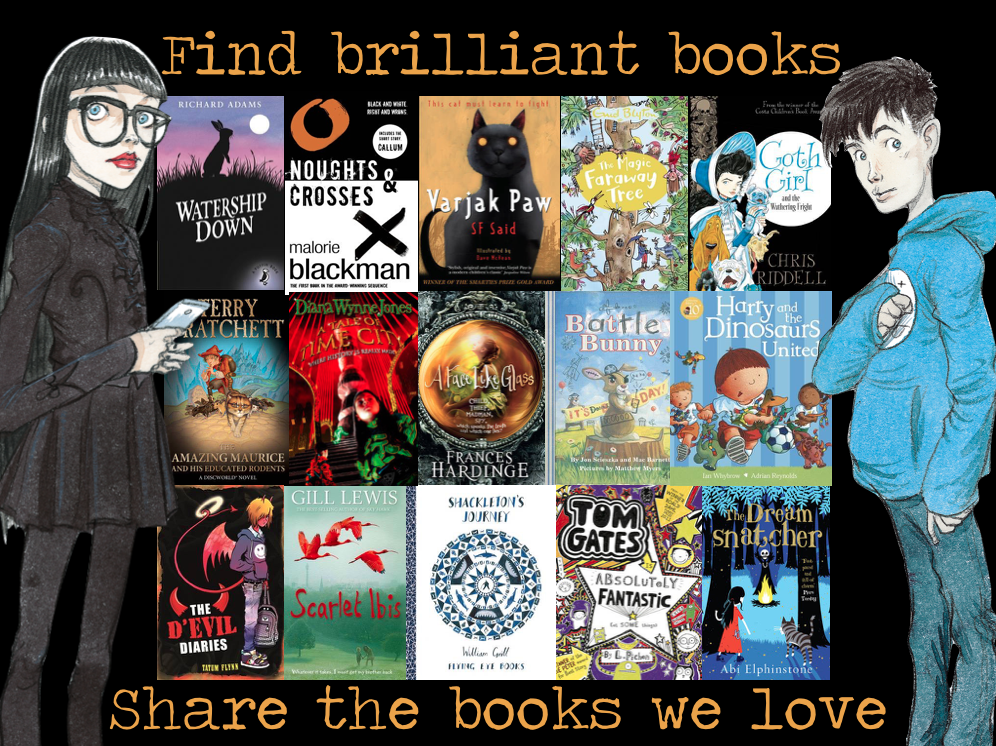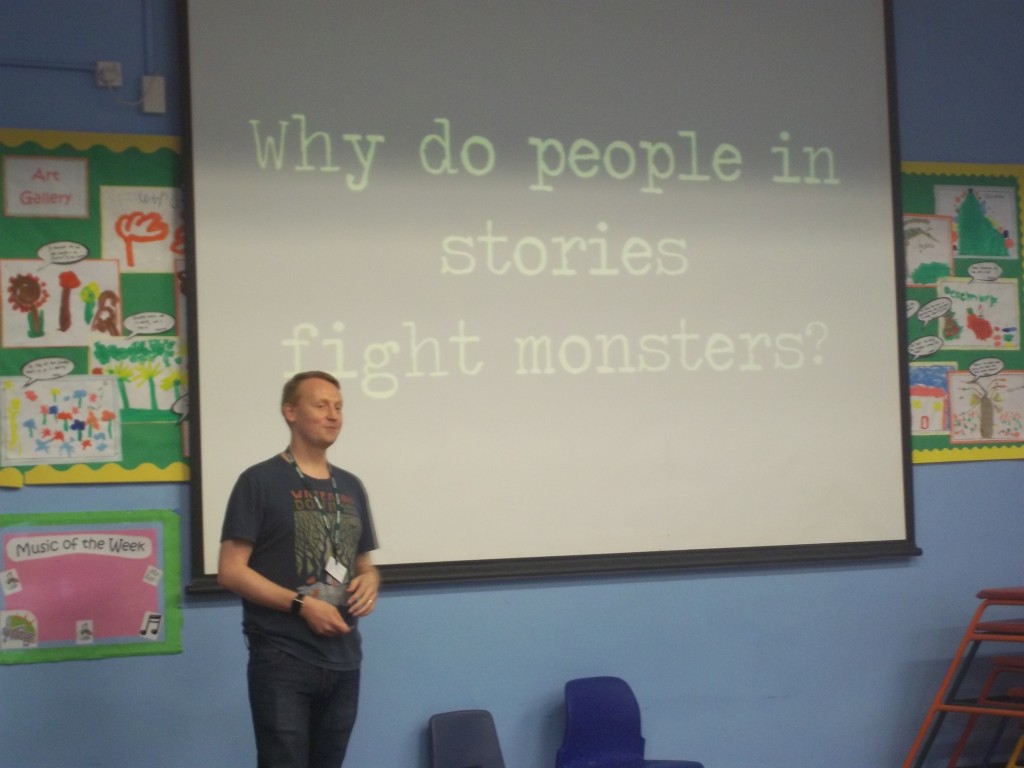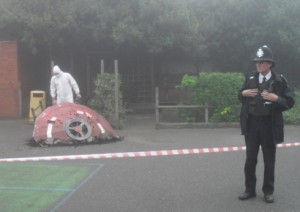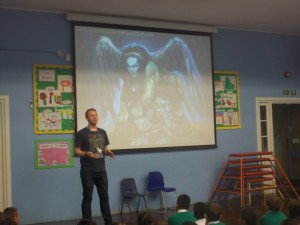
14 Sep My first day at school
You may remember that back in June, I attended a Patron of Reading event run by Big Green Bookshop Education. The Patron of Reading scheme aims to get schools to take an author on, who will then make a number of visits over the school year with the aim of promoting reading for pleasure. The minute I heard about the scheme I knew I wanted to be involved, and today I’m proud to be able to announce that I am Patron of Reading for North Harringay Primary School.
I’d met students from NHPS twice before: a number of Year Six pupils were part of the introductory event held by Big Green Education, and all of Year Five came to see me at Wood Green Library just after The Box of Demons came out. In fact, they were my first ever school group, so when Miss Emma – the school’s literacy leader – got in touch and asked me to be their Patron of Reading, I could hardly say ‘no’, could I?
One of the things I love about NHPS is they’re so proactive about getting children to think creatively. Part of the presentation I make in schools involves me talking about the local area, and how it can be used as the inspiration for fantastical stories (which is essentially what I did with The Box of Demons). When I was researching NHPS prior to that first session, I found out that they’ve already been doing that: they crash-landed a UFO in their playground to encourage creative writing. When I met with Miss Emma to talk about me becoming their Patron, she told me they plan a day like that every year, which I think is just great.
For my first day on the job, we’d arranged for me to go into reading and English lessons. My day began in a Year Two Reading lesson, where I got to see how computers are helping young children with their reading, and also how they are encouraged to discuss the books they are reading (and was most impressed by the picture of the Hulk bursting out of a hole in their classroom wall).
Next, I visited Year Six, where the students were learning to judge a book by its cover: they were looking at Alessandro Taini‘s cover for Jonathan Stroud’s The Screaming Staircase before beginning to read it as their book for the term. They were discussing what they thought the cover meant, and what it revealed about the story. I liked this approach, since it shows a healthy respect for illustrators; for the book as a physical object; and for the power of pictures in storytelling. It brought up some interesting points, and it was great to see everyone getting excited about a book they hadn’t started reading yet.
Finally, I dropped by Year Five, who were experimenting with performance poetry. They’d been working in groups to present an African poem about a bull, each trying to physicalise the text. It was interesting to see the variations they came up with, but unfortunately I didn’t get time to see all the groups in action, as I had to go and get ready for assembly.
One of the great things NHPS do is they set a question for the whole school to discuss over the course of the week. And since I was taking Monday assembly, NHPS asked me to come up with one. Miss Emma emailed me some of the previous questions, so I’d get a feel for it, and I was seriously impressed by how deep they were: “why is there something rather than nothing?”, “is it always best to get the highest score?”, “are you the same person you were when you were a baby?”, and my personal favourite, “if your two favourite characters from different books were to meet, what would happen?”
When I read the list, I realised I was going to have to up my game. So the question I asked was:
I’d been thinking about the story of Oedipus and the Sphinx, and how there’s a way of looking at it from the Sphinx’s point of view, so I told the school two stories which were really the same story. (I also showed them this brilliant picture of a sphinx by Nathan Rosario, which got a great reaction – a mixture of gasps, ‘yeurghs ‘and ‘cools’).
In the classical version, the Sphinx is a menace who preys on travellers coming into Thebes. She delights in asking her victims riddles, and then kills and eats them when they don’t get it right. Young prince Oedipus decides to rid Thebes of the monster, answers the riddle successfully, which leads to the Sphinx’s death. In my version, the Sphinx is shunned by society because she’s born different. The Thebans call her a monster and so she flees to a cave on the outskirts of town, becoming bitter and angry while having to fight off ‘heroes’ who are trying to kill her for personal gain. Then a handsome young prince comes along and charms her; she lets him in, and she falls in love. But it all turns out to be trick, and ends with the Sphinx dead and the handsome young man taking the credit.
One of my main aims as Patron of Reading is to promote reading for pleasure. I don’t want anyone to feel it is a chore, or something they have to do for school, so I want to help every child find a brilliant book. I believe there is a book out there for everyone, even the most reluctant readers, and my job is to help them find it. I read a lot, but I haven’t – you’ll be amazed to hear – read every book ever written. I’m going to need help, which is why I think it’s important for us to share the books we love. We’re going to set up a Patron of Reading email address at the school, so the children can email me with questions and suggestions. I really want to hear about the books they’re reading and enjoying (and the books they’re not enjoying: know your enemy) so I can share the joy around. I’ve got a few other ideas, too, and if I get stuck I always have the other authors in the Patron of Reading Haringey Chapter to lean on.
I showed the school a slide with some of my favourite books on it, starting with Richard Adams’s Watership Down. I asked how many children had read it, and one or two hands went up. (Hopefully I can introduce this brilliant book to a few more of the older readers). I then moved on to Varjak Paw by S.F. Said, and asked the same question. This time, most of the school put their hands up! They obviously have great taste, and I’m looking forward to helping them find other books they are equally enthusiastic about. Watch this space…







Silver Birch Class NHPS
Posted at 14:11h, 24 SeptemberHi Daniel,
We have just read your awesome blog. We appreciate all the lovely comments you made about our school and we are pleased that you enjoyed your morning with us. We also enjoyed you visiting us and we discussed your question of the week. Here are some of our answers:
“Maybe because the hero wants to show off.” Madeleine
“Maybe because the authors want to make their stories exciting.” Rebecca
“Maybe because monsters are cruel and heroes want to get their revenge.” Deniss
“Maybe because monsters are not humans.” Leila
“Maybe because the monsters may destroy where they live.” Asia
“Maybe the hero fights the monsters because he wants to protect his family.” Lorenzo
We are looking forward to seeing you again.
Love from Silver Birch Class at NHPS 🙂
Daniel Whelan
Posted at 09:17h, 28 SeptemberThose are some great answers, Silver Birch class! Especially Rebecca, very clever.